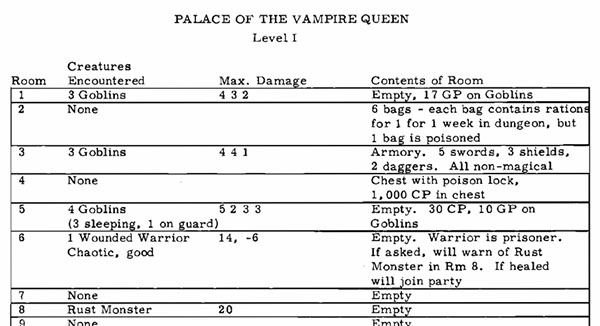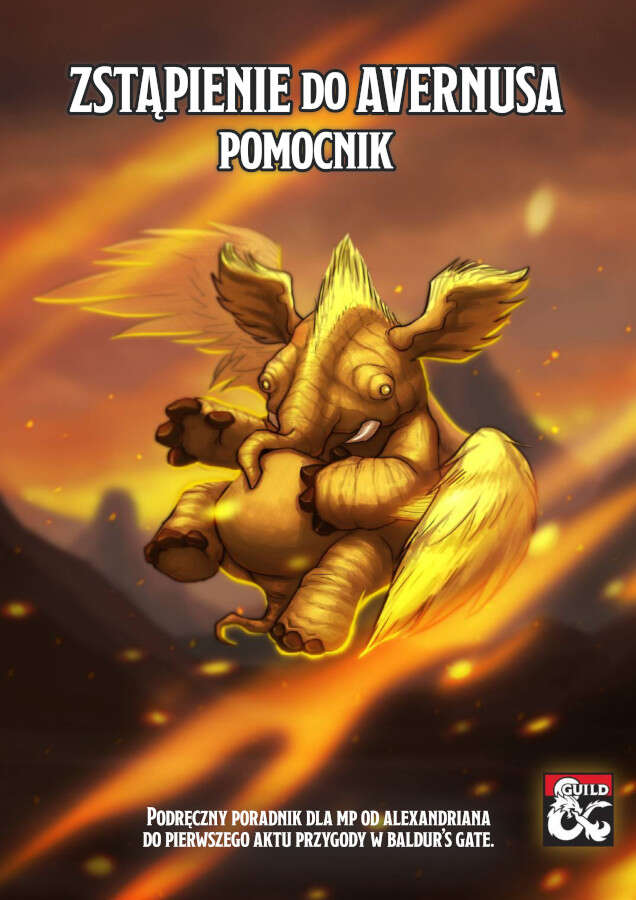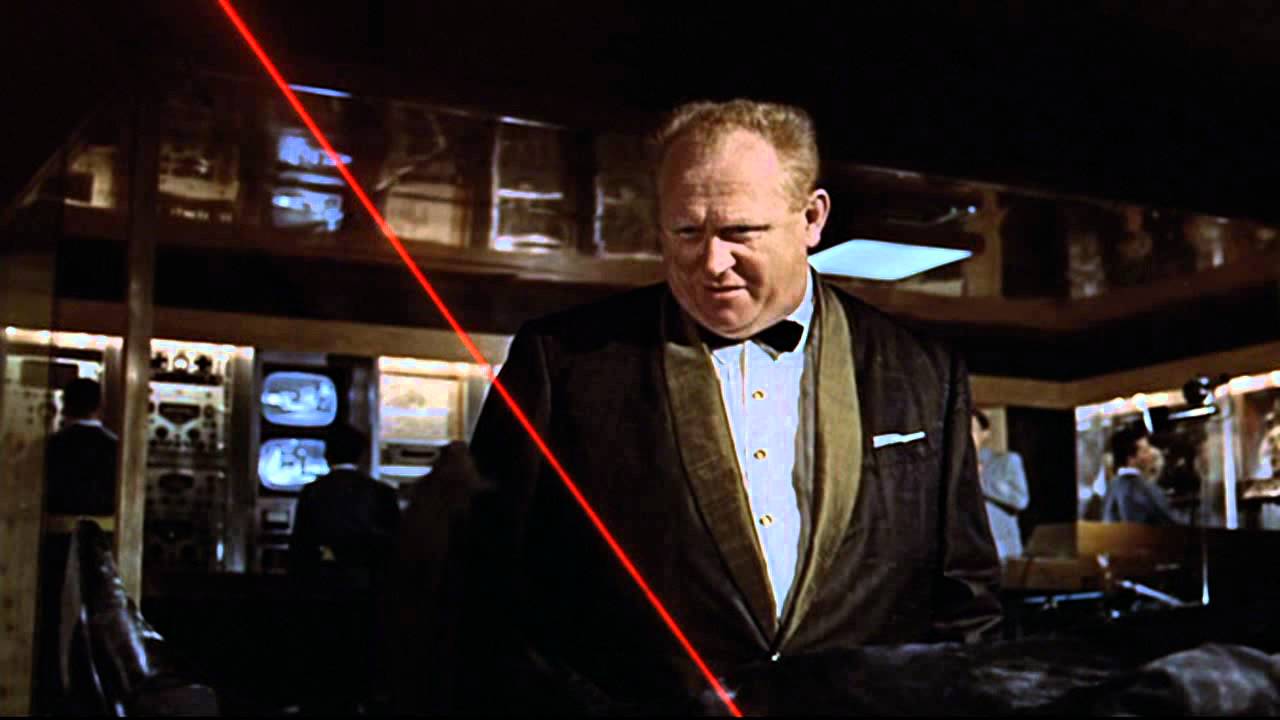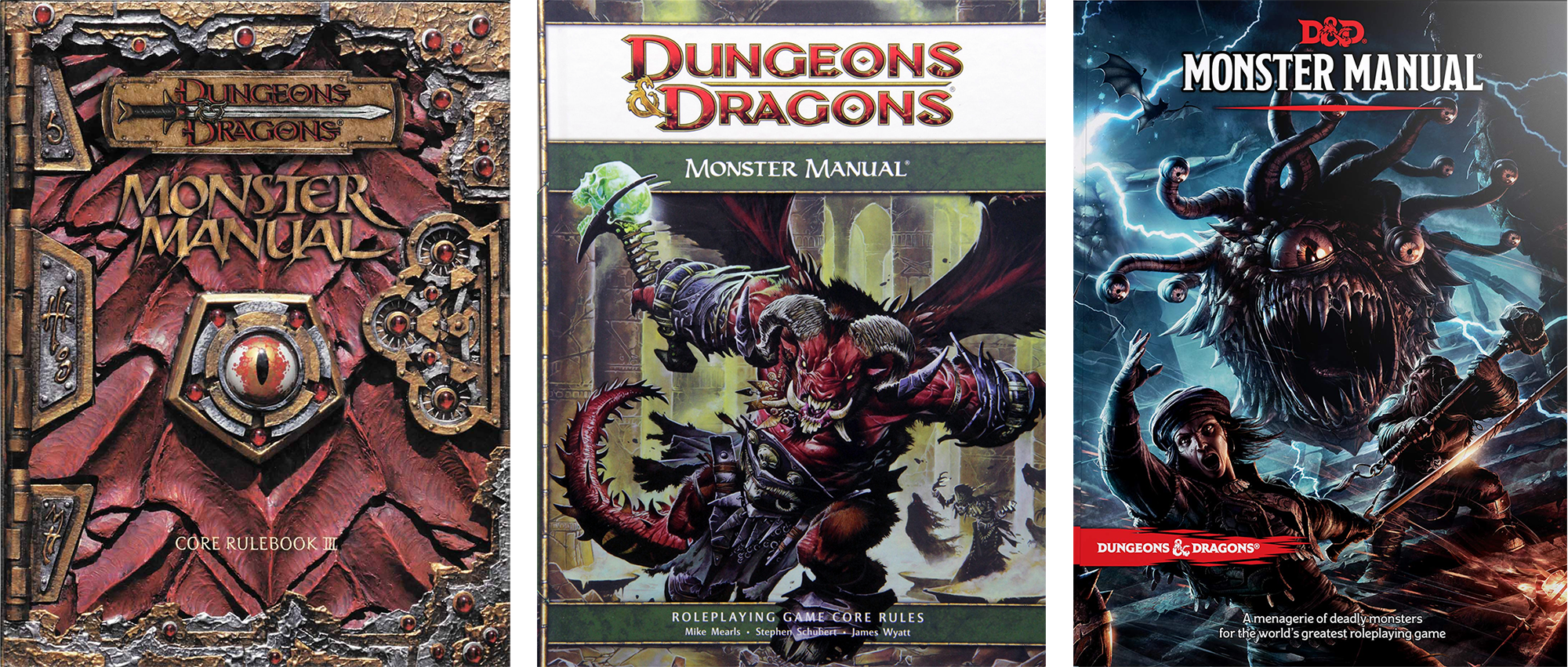
This brings us to 3rd Edition in 2000. In this new edition, every monster was made as customizable as a PC and their stat blocks ballooned as a result. For example, from The Sunless Citadel:
Jot: Quasit; CR 3; Tiny outsider (chaotic, evil); HD 3d8; hp 18; Init +3 (Dex); Spd 20 ft., fly 50 ft. (perfect); AC 18; Atk +8/+8/+3 melee (1d3-1 and poison, 2 claws; 1d4-1, bite); Face/Reach 2 1/2 ft. by 2 1/2 ft./0 ft.; SA Poison; SQ Spell-like abilities, damage reduction 5/silver, poison immunity, fire resistance 20, alternate form, regeneration 1 (normal damage from acid and holy or blessed weapon); SR 5; AL CE; SV Fort +3, Ref +6, Will +4; Str 8, Dex 17, Con 10, Int 10, Wis 12, Cha 10.
Skills and Feats: Hide +15, Listen +6, Move Silently +6, Search +4, Spellcraft +4, Spot +6; Weapon Finesse (bite, claw)
Special Attacks: Poison: Claw, Fort save resists (DC 13), initial damage 1d6 Dex, secondary damage 2d4 Dex
Special Qualities: Spell-like abilities: At will, as 6th-level sorcerer (save DCs, where applicable, are 10 + spell level), detect good, detect magic, and invisibility; 1/day cause fear (as spell, except its area is a 30-ft. radius from quasit), 1/week commune (six questions) as 12th-level cleric; speak telepathically to any creature within 100 ft.; Alternate form: polymorph self to one or two Medium-size forms.
BACK TO BASIC PRINCIPLES
These early 3rd Edition stat blocks were, frankly speaking, terrible. This was primarily the result of four things:
- Minimizing the amount of space the stat block takes up. This is legitimately motivated by the desire to make sure the information stays relatively compact. The entire point of standardizing things into a stat block, after all, is to move away from the early, casual style of describing stats narratively, and you want to keep the stat block as small as possible so that you have more room for the rest of the content in an adventure.
- An early failure to prioritize key information. This didn’t matter in early stat blocks because they were only trying to code roughly a dozen pieces of information. When there’s only a handful of entries in the stat block, it’s easy to find anything you’re looking for pretty much instantaneously. By the time 2nd Edition arrived, however, the stat block was commonly trying to code twice as much information. In 3rd Edition, the information had more than quadrupled. And the amount of information was increasing because of…
- Including all of a monster’s stats. This is obviously advantageous because you’ll avoid needing to look up information somewhere else. Replacing a chart look-up with THAC0 is one example of this, but you can see a general trend by simply glancing through the stat blocks we’ve looked at.
- A failure to minimize the presentation of certain information. For example, is it necessary to include the “SV” abbreviation to prelude the saving throws? Probably not. Another example would be “speak telepathically to any creature within 100 ft.” Couldn’t you just write “telepathy 100 ft.”? As with the 2nd Edition stat block, this is being complicated by another trend dating back to 1977: A desire in the advanced rules to codify effects as precisely as possible to eliminate any doubt, confusion, or interpretation and create a “standard” version of the game. This combines poorly with a simultaneous desire to “include all the info you need in the stat block.”
Regardless, what you had was a stat block that was very difficult to use and very easy to make mistakes with. So in July 2006, Wizards of the Coast debuted a new stat block format that was focused overwhelmingly on making it as clear and easy to use NPCs and monsters as possible. To this end it stuck with the commitment to include all the information needed to run the encounter in the stat block, and further split the stat block into five utility-based sections:
- Section 1: The information needed to begin an encounter. (What is the monster? How does it detect the PCs? Will the PCs be able to speak with it? What’s its initiative? And so forth.)
- Section 2: The information you’ll need to know on the PCs’ turn. (What’s its AC? Hit points? Saving throws? Resistances and immunities? And so forth.)
- Section 3: The information you’ll need on the monster’s turn. (What can it do? What attack options does it have? What special actions can it take?)
- Section 4: The information you don’t need to know during combat. (Or, at least, generally won’t need to know.)
- Section 5: Explanatory text. If an unusual ability is mentioned in the first four sections, its full explanation is given at the bottom of the stat block.
There was just one thing, though…
It was HUGE!
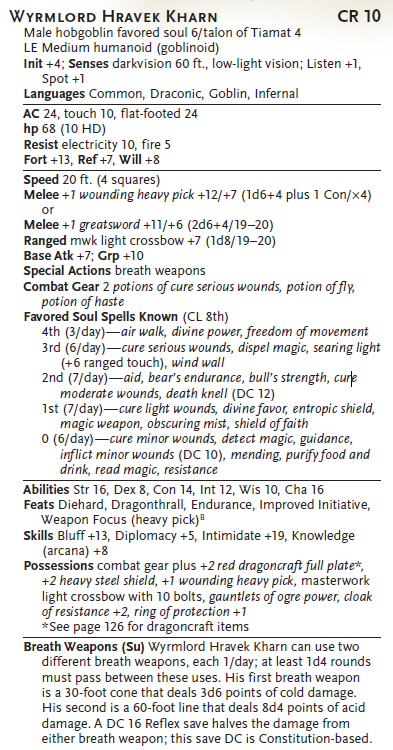
Wizards, it should be noted, wasn’t alone in this. That same year, Monte Cook, the co-designer of 3rd Edition, introduced a revised stat block in his Ptolus sourcebook. It used a similar amount of white space, but chose to focus on separating out “critical” information. A couple years later, Paizo would further tweak the schema for Pathfinder, keeping the key concept of dividing the stat block into multiple sections, but specifically labeling the sections and integrating a section describing tactics right into the middle of the stat block (Defense, Offense, Tactics, Statistics).
What strikes me as interesting about all of these efforts, however, is the degree to which they effectively concede the battle. All of these revised stat blocks were essentially indistinguishable from entries in the Monster Manual. In other words, by 2006, D&D had basically given up on the idea of the “adventure stat block” a concise summary and were basically just copy-pasting bestiary entries.
D&D 4th Edition (2008) was a radically different game from any other edition of D&D, but its stat blocks were just as chonky and continued to be duplicated directly into the adventures:
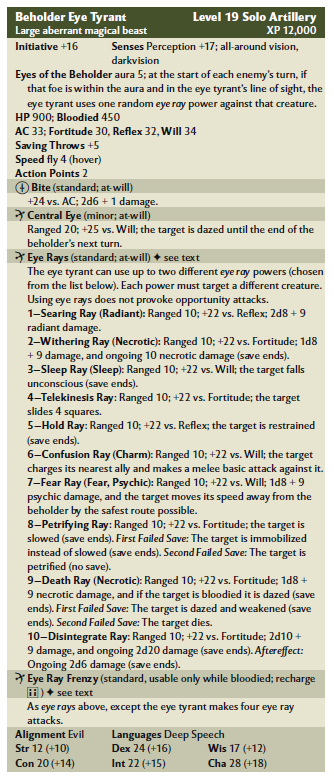
The problem was that these stat blocks were so large that they began to warp space around themselves. An encounter with two or three different stat blocks would chew up page space, creating an incredibly difficult or even impossible problem for layout to solve while flowing the text. Which, in turn, meant that DMs would have difficulty parsing the adventure.
The stat blocks were easy to use (everything you need, right at your fingertips!), but they were making everything else more difficult.
So the designers at Wizards of the Coast began looking for a solution to this new problem.
First, they experimented with putting all the stat blocks for the adventure in the back of the book. That way they wouldn’t interrupt the flow of the adventure, but they’d still be conveniently gathered together in one place for the DM. (Since even the early 3rd Edition stat blocks could get quite large, they’d started doing this with some of their adventures even before the 2006 revision.)
But what they eventually settled on was the Delve format:
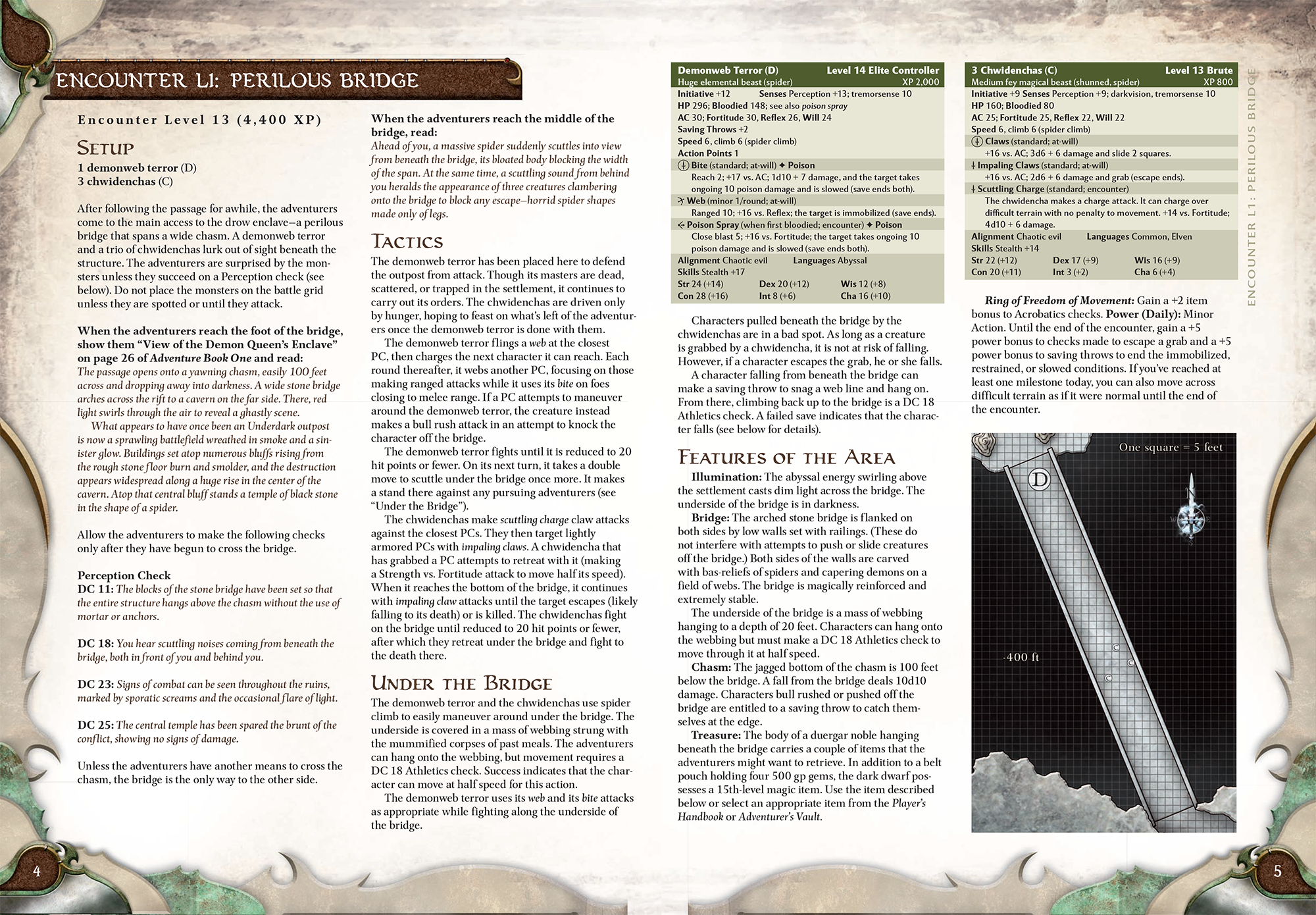
The basic concept was that every encounter would be presented as a two-page spread, allowing the stat blocks to be presented without, at least theoretically, disrupting the flow of the text. The presentation varied a little from one adventure to the next, the Delve encounters were generally presented at the end of the adventure (or, in some cases, as a separate pamphlet). The idea was that the main text of the adventure would say something like, “Now run Encounter L1,” and you’d flip the to appropriate Delve encounter.
This was another fascinating capitulation: First the stat blocks had gotten too large, so they’d been banished to the back of the book. Now the encounters were too large, so they were banished, too.
The selling point of the Delve format was, once again, that everything you needed was right on the page! It had never been easier to run an encounter! In actual practice, it was an utter disaster:
- The two-spread requirement was a classic “you gotta fill the space!” trap for designers, encouraging lots of empty verbiage that offered little or no value to the DM running the adventure.
- Conversely, if you did have an encounter that needed a lot of space to do properly, the format would force you to cram it into the limited space.
- It encouraged My Precious Encounter™ design, resulting in railroaded scenarios filled with monsters politely waiting around for the PCs to show up. (Part of this was a separate design ethos of trying to program encounters so that DMs could be reduced to dumb machines.)
- No matter where you actually put the Delve encounters in the book, they remained fundamentally bloated, chewing up space and drastically reducing the amount of playable content per page in scenarios using it. (This became painfully apparent in the few cases where Wizards of the Coast attempted to release pre-Delve scenarios in the Delve format: Often they’d be presented in books with two or three times as many pages, but nevertheless be harshly abridged to a fraction of their original content.)
When 4th Edition finished the painful process of crashing and burning in 2011, a strategic decision was made to make a firm break with its failure for the next edition of the game. Among the things summarily tossed on the rubbish bin was the Delve format.
5th EDITION
From 2012 to 2014, D&D was effectively out of print. Instead, a very public playtest called D&D Next was conducted, using a combination of PDF rules packets and published adventure books. These adventures featured some light experimentation with the structure used for location keys, but as far as monster stats were concerned, they all used the same format which remains the standard approach for 5th Edition:
- Stat blocks that do not appear in the Monster Manual are printed in an appendix at the back of the adventure.
- NPCs and monsters with stat blocks (with in the Monster Manual or the appendix) are listed in bold
Sometimes it will be indicated that the stat block appears in the adventure’s appendix (e.g., “six derro (see Appendix C)”), but frequently the DM is left to just guess where they should be looking for the stat block.
Which is just wild! Particularly since the stat block appendix is sometimes only sort of vaguely alphabetical: In Dragon Heist, for example, “Griffon Cavalry Rider” appears under the “City Guard” sub-heading and some named NPCs appear alphabetically, while others are instead grouped by the faction they belong to.
In other words, 5th Edition kinda just gave up.
As far as adventure stat blocks containing the essential information for running an encounter, D&D has more or less returned to the earliest and most primitive days of the hobby, leaving the DM to flip madly back and forth between pages and/or browser tabs in search of the stats they need.
But maybe that’s just the way it needs to be. From a certain point of view, you can argue that they’ve never managed to truly get it completely right: I’d argue the closest they got was probably during the ‘80s when the adventure stat blocks were short, concise, and could be easily integrated into an adventure key, but those also relied heavily on technical jargon and could easily baffle a new player.
Of course, D&D is not the only game in town.


